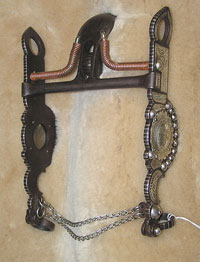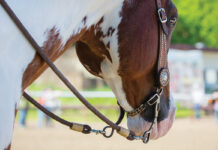
In the world of western bits, the spade is widely considered the most severe. Yet the spade bit, despite its intimidating appearance, has a historical place in the evolution of western horsemanship. The spade bit is associated with the vaquero (not charro) riding and ranching traditions of Mexico and the American southwest during the late 18th and early 19th centuries. Modern practitioners of the vaquero method take years to train their horses in hackamores and milder bits before advancing to the spade. Because of its construction, the spade bit allows a finely-schooled horse to respond to the slightest cue from the rider. As a result the horse can be ridden on a very loose rein whether it’s roaming the range or working cattle.
- The bit’s trademark component is its high port, which is shaped like a spoon or spade shovel.
- The horse naturally wants to avoid the spoon contacting the roof of its mouth. When the rider increases contact on the reins, engaging the leverage action of the bit, the horse will flex at the poll and bring its nose toward its chest. In response, the rider must loosen the reins as a reward.
- The side supports of the high port are called “braces.” They also prevent the horse from wrapping its tongue around the port.
- Quality spade bits are handmade by a few trusted artisans. Great attention is paid to ensure the bit is balanced and has smooth edges.
- Needless to say, the spade bit should only be used by veteran riders who have been properly taught by vaquero masters on its correct application. Plus the horse must have sophisticated training before it can understand signals from the spade bit.
Back to HorseChannel’s Online Bit Guide.
Back to HorseChannel’s Online Tack and Horse Equipment Guide






[…] Because of its construction, the spade bit allows a finely-schooled horse to respond to the slightest cue from the rider. As a result the horse can be ridden on a very loose rein whether it's roaming the range or working cattle. via […]